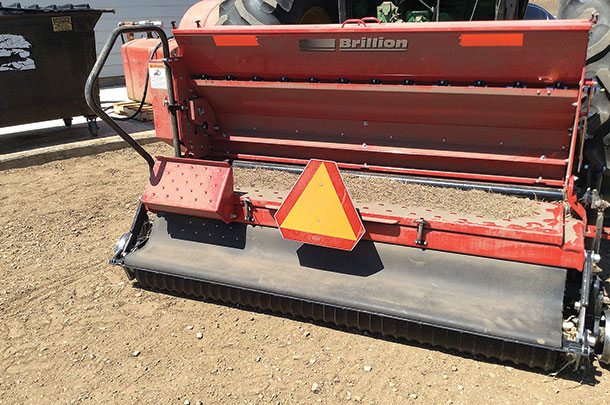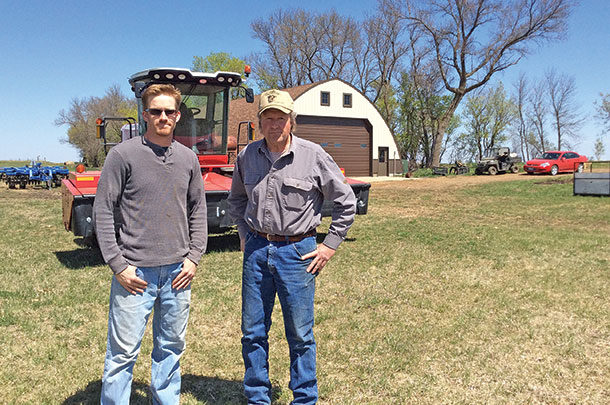Knutson has a strong incentive to produce the best possible hay for his own use and to sell to area dairies and livestock producers.
As in many other states, high humidity levels are among Knutson’s greatest challenges to consistently harvesting 300 acres of top-quality hay. He aims to bale it when forage moisture levels are between 13.5 and 14 percent.
Variety matters
Knutson’s process for harvesting quality alfalfa begins with variety selection and finding alfalfa that is fine-stemmed and produces plenty of leaves. Finer stems tend to dry down faster after cutting, and a greater leaf ratio provides the best potential for high quality.
“Alfalfa leaves contain the most feed value,” Knutson says. “Adding soft-leaved tall fescue to the alfalfa also helps dry it down faster.”
Knutson uses STF-43, which is a blend of late-maturing, soft-leaved tall fescues that produces high dry matter yields that contain exceptional levels of digestible fiber. The blend was formulated to provide extraordinary levels of digestible fiber per pound of dry matter.
Livestock consuming STF-43 derive energy from the combination of digestible fiber and fiber that promotes rumen health and productivity. The blend is late-maturing and endophyte-free. Knutson’s fields are seeded at a per-acre rate of 18 pounds of alfalfa and 6 pounds of fescue.
“If you use a grass blend with alfalfa, you want a late-maturing variety so it doesn’t start heading out before the alfalfa is ready,” Knutson says. “If alfalfa starts producing blooms before it’s cut, or the grass starts heading out before it’s cut, the protein levels of the forage are quickly reduced.”
Fine-tuned timing
Soil types in Knutson’s fields vary greatly from black silt to clay. In an area where land forms a range from hilly to rolling, most of Knutson’s fields contain some degree of slope. Summer rainfall can be very spotty, often coming as short, hard showers that can include strong wind.
Temperature extremes are common in every season with moist, cool and windy springs; sunny and hot summers; cool, dry and sunny fall conditions; and a relatively long, cold winter.
“The window for putting up hay can be as short as a couple hours a day,” Knutson says. “It all depends on humidity levels, which are sometimes too high to dry the hay or too low, causing a lot of leaf loss during baling.”
Winterkill in Knutson’s area can be caused by lack of snow cover or persistent ice cover, which can smother plants or damage them because of the low insulation value of ice. Extremely low temperatures or extreme temperature fluctuation can also damage plants. Frost heaving, which can force alfalfa crowns and roots above the soil surface, can also damage fields.
Protecting quality
Maintaining a healthy alfalfa stand is one of Knutson’s defenses against winterkill. Fertilizer is usually applied after each cutting. The soil sample he collects in the fall guides fertilizer application.
“For grasses, the biggest nutrient is nitrogen,” Knutson says. “I use a combination of ammonia sulfate and urea after every cutting. Generally, I apply 40 pounds of nitrogen per acre. I believe this is more effective and efficient than applying all the fertilizer one time in the spring. I probably harvest about 20 percent more tons per acre with this fertilizer plan.”
If moisture is adequate, Knutson applies granular fertilizer, which subsequent rains will carry down to alfalfa roots. If weather conditions are dry, which can be common after the second or third cutting, he uses a foliar fertilizer application to ensure plants are able to take it up.
Consistent feed value
Knutson’s alfalfa protein levels routinely average between 20 and 23 percent. Relative feed value (RFV) ranges from 150 to 200. While he conducts his own testing from time to time, buyers generally select their own samples for testing before purchasing bales.
“If we can cut alfalfa before it starts blooming, RFV remains high,” Knutson says. “If it’s rainy and we have to wait, the flowers will take RFV down pretty quickly.”
In addition to alfalfa, Knutson produces about 100 acres of grass hay that’s primarily a soft-leaf fescue blend with some orchardgrass. The grass hay cures faster than alfalfa and makes a high-protein, palatable forage for livestock.
“It averages about 20 percent protein,” Knutson says. “You don’t have to worry about losing leaves if it’s baled when it’s a little dry. Quality grass hay sells for about the same price as alfalfa, sometimes even more. Dairies in this area use grass hay to balance rations and for feeding dry cows.”
If moisture is scarce, Knutson may apply pesticide to deal with aphids or weevils. Pest issues aren’t an annual concern but do occur.
Weed management is key anytime Knutson establishes a new grass planting. If weeds become a problem in new grass stands, he doesn’t spray them until grass goes into a second year of growth.
“There’s usually some weed pressure with new seedings,” Knutson says. “I use 2,4-D, which will kill at least some young grass if you use it that first year.”
Putting it down – picking it up
Knutson relies on fast, efficient haying equipment for the best possible harvest results. His Massey Ferguson WR 9770 windrower is a 200-plus horsepower machine designed to operate in heavy crop conditions like hilly, rough terrain and wet silage hay.

The machine’s 6.6-liter AGCO Power engine uses four valves per cylinder to enhance airflow and increase horsepower for high-capacity mowing.
Among the windrower features Knutson appreciates are the rotary head and double crimper. “This machine crimps the stems about every 1.5 inches instead of every 3 to 4 inches,” Knutson says. “That reduces drydown time quite a bit.”
Typically, Knutson cuts stubble at about 4 inches so the plants retain enough leaf area to continue the photosynthesis process. The stubble height also holds cut hay far enough off the ground to facilitate drying.
A Claas rotary rake and Claas wheel rake help handle the hay. Two John Deere round balers, a 568 and 569 Premium, help Knutson make short work of a hayfield once it’s dried down. The 569 Premium model features mega-wide pickup and high-quality belts and chains that help reduce downtime.
“The key to making a good bale is making it as dense and tight as possible,” Knutson says. “Our bales average 1,800 to 2,000 pounds. We use edge-to-edge wrap and put two rounds of wrap to help maintain a tight bale.”
Bringing it home
If his hay is rained on before it’s baled, Knutson allows it to go through a sweat before storing it in either a 65-by-40-foot or 65-by-100-foot hoop barn built just for storing his hay crop.
His bales, generally 5 by 6 feet, are pyramid-stacked, allowing for storage of up to 1,200 tons of hay.
“The 30-foot height of the hoop barn makes it easy to work in,” Knutson says. “We don’t have to worry about bumping trusses when we raise the loader. There are no internal support posts, which maximizes storage. The extra air space allows the hay to breathe, too.”
In spite of all the challenges he faces, Knutson expects to stay in the hay business well into the future. His own need for quality hay for his livestock motivates him to keep pushing for top quality.
“I enjoy working with hay, and our focus on developing our cattle on forage is a great incentive to do the best possible job,” Knutson says. “We’re always looking to put up quality hay and maintain it with our storage system.” FG
Loretta Sorensen is a freelancer based in South Dakota.
PHOTO 1: Gary Knutson and his son, Kyle, work together as a team to produce high-quality hay for their livestock and for neighboring dairies.
PHOTO 2: Knutsons carefully choose equipment that best fits their needs and offers quality and durability. The small rear roller on the Brillion seeder squeezes soil around the seed to enhance seed-to-soil contact and consistent seed placement. Photos courtesy of Loretta Sorensen.











